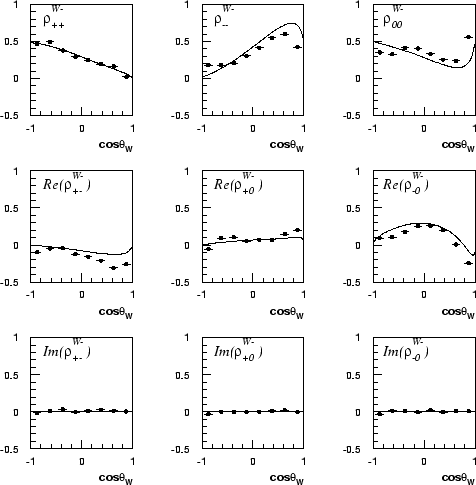The SDM elements extracted from the data
will not represent the true SDM elements. The
less than perfect angular resolution, the finite selection efficiency and the
acceptance of the OPAL detector are just some of the factors that will
have an effect on
the SDM elements. The data sample is expected to contain some background
events and these will also cause deviation from the true SDM elements. The
problem is increased further when you include such effects as ISR and the
finite W width.
Figure 6.1 indicates the extent of the problem detector effects cause. It shows the SDM
elements extracted from a sample of fully detector simulated Monte Carlo events
containing all possible signal and background processes. They have been
passed
through the same selection and reconstruction as is used for the data. Overlaid
is the theoretical prediction for the Standard Model calculated from the purely
analytical expression of the process
![]() , equation 3.29.
, equation 3.29.
 |
The deviations due to the experimental effects are obvious in
figure 6.1.
The SDM elements extracted from the data cannot be
directly compared with the theoretical predictions from the analytical
formula, however they can be compared directly
to SDM elements extracted
from fully detector simulated Monte Carlo.
The ![]() curve is formed from the difference between
SDM elements obtained from the data and from fully simulated Monte Carlo with
different values of TGC.
curve is formed from the difference between
SDM elements obtained from the data and from fully simulated Monte Carlo with
different values of TGC.
A large number of samples of fully detector simulated Monte Carlo generated with a wide
range of anomalous couplings are not available, so a different method is required
to produce samples that can then be used in the ![]() minimisation. A
reweighting technique is employed to produce Monte Carlo samples with
an arbitrary coupling. This method is discussed below.
minimisation. A
reweighting technique is employed to produce Monte Carlo samples with
an arbitrary coupling. This method is discussed below.